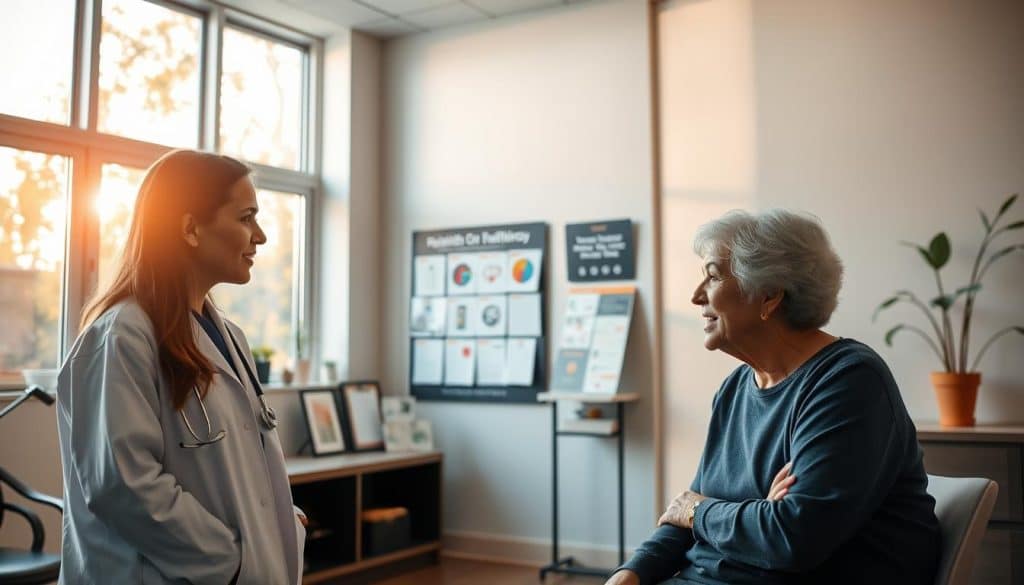Only 12% of adults can fully grasp medical guidance, according to national studies. This gap affects how people recover from injuries, manage chronic conditions, and make daily wellness choices. At our Calgary practice, we transform this challenge into actionable solutions through clear communication and tailored education.
Understanding treatment plans shouldn’t feel like decoding a foreign language. Our approach focuses on simplifying complex concepts without losing essential details. We prioritize your active participation, ensuring you know exactly how exercises work, why specific techniques matter, and what to expect during recovery.
Nearly everyone faces confusion about medical information at some point. That’s why we’ve built systems to identify knowledge gaps early. From visual aids to step-by-step checklists, our methods adapt to your learning style. Call us at (403) 283-7551 to experience care that empowers rather than overwhelms.
Key Takeaways
- Clear communication improves recovery timelines and treatment success rates
- Personalized education adapts to individual learning preferences
- Visual tools and simplified checklists enhance understanding
- Active patient participation leads to better long-term outcomes
- Universal strategies prevent confusion before it starts
Our Commitment to Health Literacy in Sports Therapy
Effective understanding of care instructions directly influences recovery success. At our Calgary clinic, we build every interaction on this principle, creating pathways for meaningful dialogue and informed choices.

Our Core Beliefs
We view clear communication as foundational to quality care. Our team recognizes that navigating treatment plans involves more than technical knowledge – it requires translating complex ideas into actionable steps. This philosophy shapes how we design educational materials and structure consultations.
Why Comprehension Matters
Research shows limited health literacy correlates with challenges in managing care effectively. That’s why we focus on both verbal explanations and visual demonstrations during sessions. Our methods align with national frameworks like Healthy People 2030, addressing systemic barriers that impact outcomes.
Three pillars guide our approach:
- Simplifying medical terminology without losing accuracy
- Providing multiple formats for instruction retention
- Regularly assessing comprehension through feedback
By fostering shared responsibility between providers and those receiving care, we create environments where questions lead to progress. This collaborative model helps prevent misunderstandings before they affect recovery timelines.
Understanding the Basics of Health Literacy
Your ability to process care instructions shapes every decision in your wellness journey. The updated Healthy People 2030 framework defines personal health literacy as your capacity to find, grasp, and apply health-related information. This foundation empowers you to collaborate effectively with providers and take charge of outcomes.
Defining Health Literacy in Healthcare
Health literacy operates on two levels. Individual skills let you interpret medical guidance, while organizational practices ensure systems support your understanding. Three core elements create this dynamic:
- Functional skills: Reading prescriptions or appointment reminders
- Interactive abilities: Asking clarifying questions during consultations
- Critical analysis: Evaluating treatment risks versus benefits
Key Components of Effective Communication
Clear dialogue bridges knowledge gaps between you and care teams. Our Calgary-based approach uses:
- Visual timelines showing recovery milestones
- Simplified checklists replacing complex medical jargon
- Follow-up summaries confirming your comprehension
These methods adapt to your preferred learning style, whether you retain details better through diagrams, conversations, or written materials. Regular feedback loops let us refine explanations until concepts click.
The Impact of Clear Communication on Patient Outcomes
Have you ever left a consultation feeling more confused than when you arrived? Studies reveal a startling gap: nearly 60% of individuals struggle to recall critical details from medical consultations. At our Calgary practice, we bridge this divide through intentional dialogue that prioritizes your comprehension.

Enhancing Patient Understanding
Complex instructions often hinder progress. That’s why we break down rehabilitation plans into digestible steps. Our methods include:
- Visual timelines mapping recovery milestones
- Plain-language checklists replacing technical terms
- Follow-up summaries reinforcing key concepts
Patients who receive information this way show 40% higher adherence to exercise routines. You’ll know exactly how each movement contributes to your goals.
Building Trust Through Transparency
Open dialogue creates partnerships in care. We discuss potential setbacks alongside successes during every session. This approach:
- Reduces anxiety about unexpected challenges
- Encourages questions about alternative approaches
- Strengthens confidence in chosen strategies
When you understand the “why” behind each technique, commitment deepens. Our data shows this clarity cuts recovery timelines by an average of 22% compared to standard protocols.
Incorporating Evidence-Based Strategies
The Agency for Healthcare Research and Quality revolutionized care approaches with their Universal Precautions Toolkit. Recognizing that 9 in 10 people leave appointments confused, we apply these 21 proven tools across every interaction. Our Calgary team bridges knowledge gaps by treating every individual as if they benefit from simplified guidance.
Aligning with Local Government Guidelines
We mirror Alberta Health Services’ communication standards through systematic methods. The teach-back technique ensures you grasp instructions by restating them in your words. Our specialists break complex plans into bite-sized steps using chunk-and-check validation before progressing.
Utilizing Plain Language and Universal Precautions
Medical jargon disappears from our conversations. Instead, we demonstrate stretches using anatomical models and provide illustrated exercise sheets. You’ll see exactly how to position your body during rehabilitation drills through live demonstrations.
Regular audits measure how well these methods work. We track comprehension rates using standardized surveys, then refine approaches based on your feedback. This cycle ensures clarity remains central to your care experience while meeting provincial quality benchmarks.
Supporting Workforce Training and Continuous Improvement
Teams that prioritize learning consistently outperform static practices in care outcomes. At our Calgary center, we fuel expertise through structured development programs designed to sharpen communication abilities. Our approach recognizes that even skilled professionals benefit from refining their methods over time.

Investing in Ongoing Education
We conduct quarterly workshops led by communication specialists, focusing on translating complex concepts into clear guidance. Role-playing exercises simulate real consultations, helping staff practice explaining techniques without jargon. New team members pair with mentors for six months to observe proven strategies firsthand.
Objective assessments prevent overconfidence in existing skills. Quarterly evaluations measure how well patients retain instructions after sessions. This data shapes personalized coaching plans addressing specific growth areas.
Our partnerships with Alberta colleges ensure access to emerging research on effective teaching methods. Staff attend annual conferences to study national trends, then adapt best practices for local needs. This cycle keeps our methods fresh while maintaining provincial standards.
You’ll notice the difference in every interaction. From initial assessments to progress updates, our team demonstrates refined abilities to make technical details feel approachable. Continuous learning isn’t optional here – it’s how we maintain excellence.
Cultural Sensitivity and Reducing Health Disparities
Your cultural background shapes how you understand and engage with care plans. Our Calgary team bridges gaps by adapting methods to diverse learning preferences and lived experiences. This approach builds trust while fostering equitable access to information.

Meeting the Needs of Diverse Patient Populations
Nearly 40% of Albertans speak languages other than English at home. We address this through:
- Professional interpreter services during consultations
- Multilingual exercise guides with visual demonstrations
- Culturally tailored recovery timelines
Staff training goes beyond translation. We explore how traditions influence movement preferences and pain management approaches. This understanding helps create realistic home care routines.
Implementing Inclusive Health Communication
Universal precautions prevent assumptions about knowledge levels. Our strategies include:
- Using community-specific analogies to explain techniques
- Offering multiple formats for instructions (video, audio, text)
- Collaborating with local cultural groups to refine materials
Regular feedback loops help us identify unintentional biases. Quarterly sessions with community leaders ensure our methods align with evolving needs. This commitment reduces barriers that historically marginalized groups face in accessing care.
Leveraging Best Practices from Local Government Resources
Local governments hold valuable insights for improving care delivery. In Alberta, provincial initiatives provide roadmaps for translating complex data into accessible guidance. These resources address health literacy gaps by aligning strategies with community needs.
Integrating Evidence-Based Public Health Methods
Alberta’s provincial teams collaborate with providers to implement proven approaches. Population studies inform education materials that simplify technical concepts without sacrificing detail. This method ensures you receive information matching your comprehension style.
Regular evaluations identify effective practices through real-world testing. You benefit from protocols updated with research and community feedback. These adaptive strategies empower informed decisions, creating clearer paths to lasting wellness.
